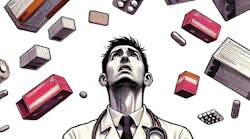My first job in Pharma was in the Package Materials Testing Group (me) to develop a new (in 1970) approach called “plastic bottles” to replace traditional glass bottles. Another strange, new idea we played with was something called “blister packs.” Originally, the reasons for switching from amber glass to plastic bottles were 1) safety (glass breaks, remember?) and 2) cost savings. The blister packs were to replace “strip packages,” used by doctors for samples… later found to be good for selling product, as well.
Sounds like an easy switch, but in 1970, interactions between drug products and polymers (and additives) were not known. There is a potential for the API to migrate into the container and, conversely, some of the chemicals (anti-oxidants, mold-release agents, etc.) can migrate into the drug product and either react or “merely” be ingested.
One early example was a trial insertion of the dropper into the bottle of nose drops. Shipping it this way allowed for a smaller package. Since the earlier droppers were glass, for both safety and weight, they were replaced with a polypropylene one. We quickly discovered that the preservative (thimerosal) was absorbed by the dropper, meaning that the first time it was used and replaced, the bottle was an incubator for whatever bacteria came from the patient. A hand lotion, packed in a PVC bottle, extracted the organotin antioxidant from the polymer. Clearly, some R&D was needed.
Switching from glass to plastic also had some physical difficulties, too. The simplest was the shape and height of the bottle itself. As tablets are filled at a rapid rate, they bounce off the bottom and ricochet off the curved shoulders. Months of experimentation were needed to determine the correct parameters to keep chipping and breakage at a minimum. And then there was the cap.
Formerly, on glass bottles with metal caps, there was a paper liner that adhered to the glass when the cap was tightened to a pre-determined torque. Well, the adhesive used didn’t stick to polymers, metal caps didn’t work, and plastic “creeps” when torqued to the required tightness, becoming looser with time. Clearly ALL specs needed to be changed. To “ice the cake,” so to speak, current labels didn’t adhere to the polymers. So they allowed me, a newly minted Physical Chemist, free-rein in the lab.
Fortunately, we had some nice instruments, one of which was an Instron stress measuring device. I used a punch to cut samples from the bottles, along the long and short axes, shaped like mini-barbells. These were clamped into the claws of the device and slowly stretched to the tear-point, determining the tensile strength. An average of several batches were determined, the bottles were then subjected to stability conditions (heat, light, humidity) both empty and with the tablets for which they were intended. As samples were taken at time points, empty and filled bottles had their tensile and tear strengths tested to see if the product affected them.
Also, since the native polymers offered little protection from light, we needed to ascertain the percentage of TiO2 that needed to be added. Less than 3 percent allowed light to degrade the product and more than 3 percent made the bottle brittle, so that’s how we chose 3 percent. Then we had to evaluate blister packs for distribution.
A lot of travel was involved, since the technology was not ubiquitous. But as we began determining what polymers and which coatings were best, someone had the idea that they would also be good for clinical trials. They could be filled by hand and they could all be different, allowing double-blind studies to be run.
One of the recurring problems of pharmaceutical companies (and the cause of many warning letters and recalls) is mislabeling and incorrect drug product in containers. The bulk tablets or capsules arrive in fiber drums or plastic containers, identified by a label, possibly hand-written and certainly hand-attached. The materials are placed in bottles or blisters, based on “faith” that the labels are correct. Since this is often not the case, I have suggested that a simple, hand-held NIR or Raman instrument be placed in the packaging room for final assurance that the proper product is packaged. After all the work in developing the package-product marriage, it’s the least we can do. Now, nearly 50 years later, these containers are taken for granted, but if you meet a packaging engineer, tell him, “Thank you.”




